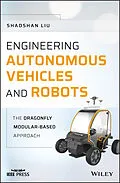Offers a step-by-step guide to building autonomous vehicles and robots, with source code and accompanying videos
The first book of its kind on the detailed steps for creating an autonomous vehicle or robot, this book provides an overview of the technology and introduction of the key elements involved in developing autonomous vehicles, and offers an excellent introduction to the basics for someone new to the topic of autonomous vehicles and the innovative, modular-based engineering approach called DragonFly.
Engineering Autonomous Vehicles and Robots: The DragonFly Modular-based Approach covers everything that technical professionals need to know about: CAN bus, chassis, sonars, radars, GNSS, computer vision, localization, perception, motion planning, and more. Particularly, it covers Computer Vision for active perception and localization, as well as mapping and motion planning. The book offers several case studies on the building of an autonomous passenger pod, bus, and vending robot. It features a large amount of supplementary material, including the standard protocol and sample codes for chassis, sonar, and radar. GPSD protocol/NMEA protocol and GPS deployment methods are also provided. Most importantly, readers will learn the philosophy behind the DragonFly modular-based design approach, which empowers readers to design and build their own autonomous vehicles and robots with flexibility and affordability.
* Offers progressive guidance on building autonomous vehicles and robots
* Provides detailed steps and codes to create an autonomous machine, at affordable cost, and with a modular approach
* Written by one of the pioneers in the field building autonomous vehicles
* Includes case studies, source code, and state-of-the art research results
* Accompanied by a website with supplementary material, including sample code for chassis/sonar/radar; GPS deployment methods; Vision Calibration methods
Engineering Autonomous Vehicles and Robots is an excellent book for students, researchers, and practitioners in the field of autonomous vehicles and robots.
Autorentext
SHAOSHAN LIU, PHD, is Founder and CEO of PerceptIn, a full-stack visual intelligence company aimed at making scalable hardware/software integrated solutions for autonomous robotics systems. Liu holds a Ph.D. in Computer Engineering from University of California, Irvine and his research focuses on Edge Computing Systems, Robotics, and Autonomous Driving. Liu has over 40 publications and over 100 patents in autonomous systems. Liu is currently a Senior Member of IEEE, an ACM Distinguished Speaker, an IEEE Computer Society Distinguished Visitor, and a co-founder of the IEEE Computer Society Special Technical Community on Autonomous Driving Technologies.
Inhalt
1 Affordable and Reliable Autonomous Driving Through Modular Design 1
1.1 Introduction 1
1.2 High Cost of Autonomous Driving Technologies 2
1.2.1 Sensing 2
1.2.2 HD Map Creation and Maintenance 3
1.2.3 Computing Systems 3
1.3 Achieving Affordability and Reliability 4
1.3.1 Sensor Fusion 4
1.3.2 Modular Design 5
1.3.3 Extending Existing Digital Maps 5
1.4 Modular Design 6
1.4.1 Communication System 7
1.4.2 Chassis 7
1.4.3 mmWave Radar and Sonar for Passive Perception 8
1.4.4 GNSS for Localization 8
1.4.5 Computer Vision for Active Perception and Localization 8
1.4.6 Planning and Control 8
1.4.7 Mapping 9
1.5 The Rest of the Book 9
1.6 Open Source Projects Used in this Book 10
References 11
2 In-Vehicle Communication Systems 13
2.1 Introduction 13
2.2 CAN 13
2.3 FlexRay 16
2.3.1 FlexRay Topology 16
2.3.2 The FlexRay Communication Protocol 17
2.4 CANopen 18
2.4.1 Object Dictionary 19
2.4.2 Profile Family 19
2.4.3 Data Transmission and Network Management 20
2.4.4 Communication Models 21
2.4.5 CANopenNode 21
References 22
3 Chassis Technologies for Autonomous Robots and Vehicles 23
3.1 Introduction 23
3.2 Throttle-by-Wire 23
3.3 Brake-by-Wire 25
3.4 Steer-by-Wire 25
3.5 Open Source Car Control 26
3.5.1 OSCC APIs 26
3.5.2 Hardware 27
3.5.3 Firmware 28
3.6 OpenCaret 29
3.6.1 OSCC Throttle 29
3.6.2 OSCC Brake 29
3.6.3 OSCC Steering 29
3.7 PerceptIn Chassis Software Adaptation Layer 30
References 34
4 Passive Perception with Sonar and Millimeter Wave Radar 35
4.1 Introduction 35
4.2 The Fundamentals of mmWave Radar 35
4.2.1 Range Measurement 36
4.2.2 Velocity Measurement 37
4.2.3 Angle Detection 38
4.3 mmWave Radar Deployment 38
4.4 Sonar Deployment 41
References 45
5 Localization with Real-Time Kinematic Global Navigation Satellite System 47
5.1 Introduction 47
5.2 GNSS Technology Overview 47
5.3 RTK GNSS 49
5.4 RTK-GNSS NtripCaster Setup Steps 52
5.4.1 Set up NtripCaster 52
5.4.2 Start NtripCaster 54
5.5 Setting Up NtripServer and NtripClient on Raspberry Pi 55
5.5.1 Install the Raspberry Pi System 55
5.5.2 Run RTKLIB-str2str on the Raspberry Pi 57
5.5.2.1 Running NtripServer on the Base Station Side 57
5.5.2.2 Running NtripClient on the GNSS Rover 58
5.6 Setting Up a Base Station and a GNSS Rover 59
5.6.1 Base Station Hardware Setup 59
5.6.2 Base Station Software Setup 60
5.6.3 GNSS Rover Setup 67
5.6.3.1 Rover Hardware Setup 67
5.6.3.2 Rover Software Setup 68
5.7 FreeWave Radio Basic Configuration 71
References 75
6 Computer Vision for Perception and Localization 77
6.1 Introduction 77
6.2 Building Computer Vision Hardware 77
6.2.1 Seven Layers of Technologies 78
6.2.2 Hardware Synchronization 80
6.2.3 Computing 80
6.3 Calibration 81
6.3.1 Intrinsic Parameters 81
6.3.2 Extrinsic Parameters 82
6.3.3 Kalibr 82
6.3.3.1 Calibration Target 83
6.3.3.2 Multiple Camera Calibration 83
6.3.3.3 Camera IMU Calibration 84
6.3.3.4 Multi-IMU and IMU Intrinsic Calibration 84
6.4 Localization with Computer Vision 85
6.4.1 VSLAM Overview 85
6....
